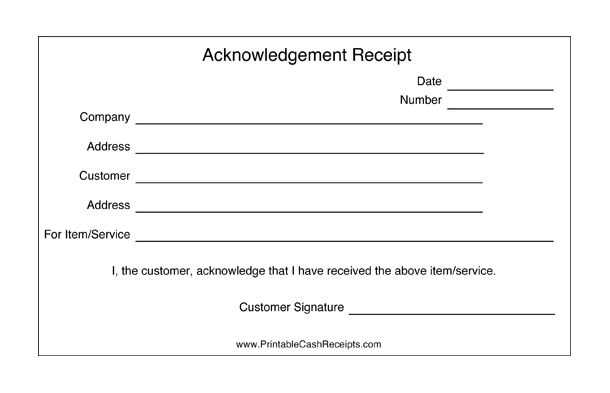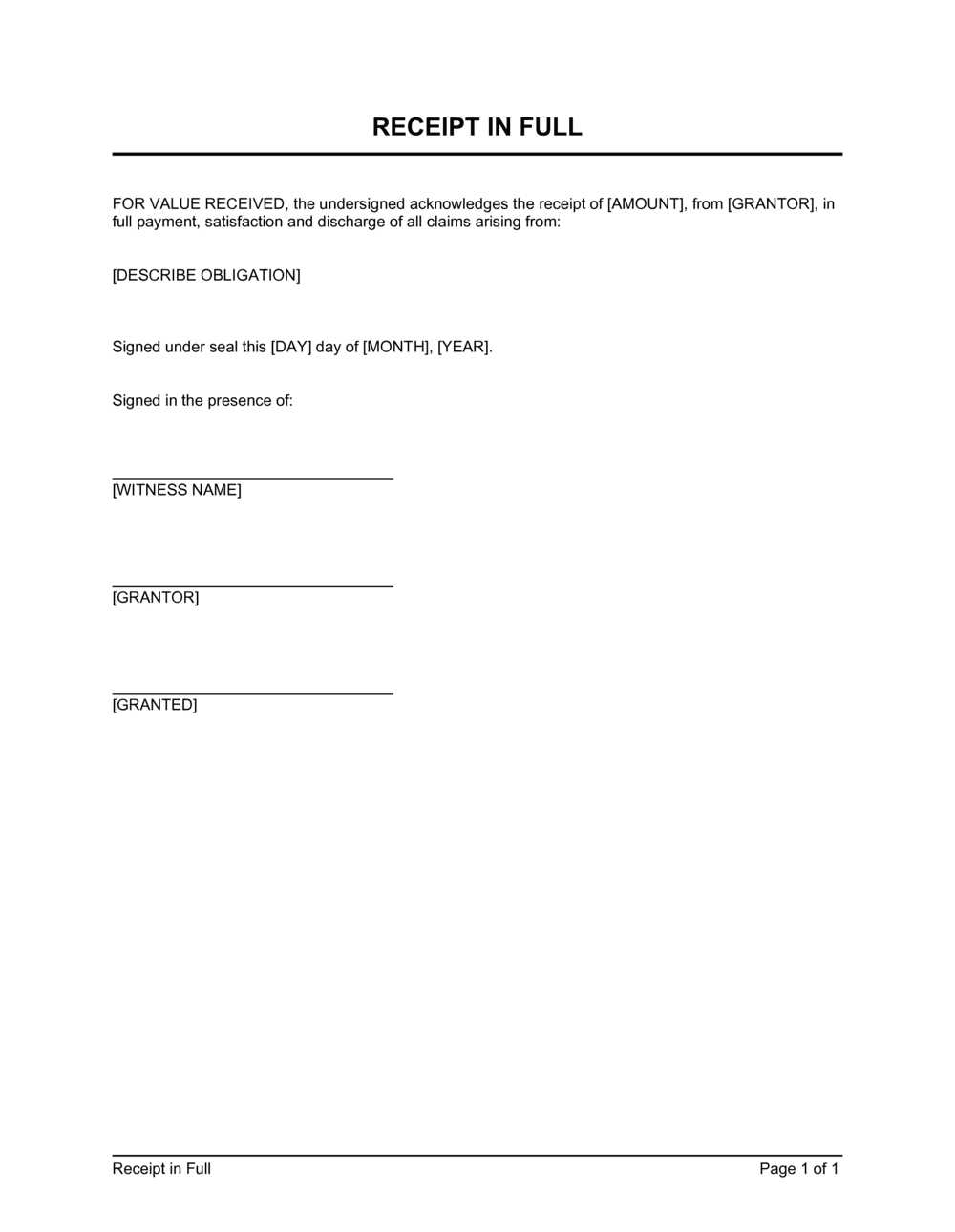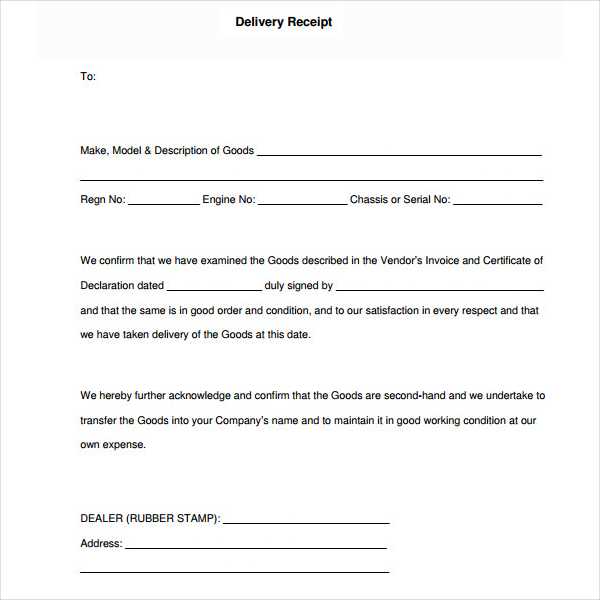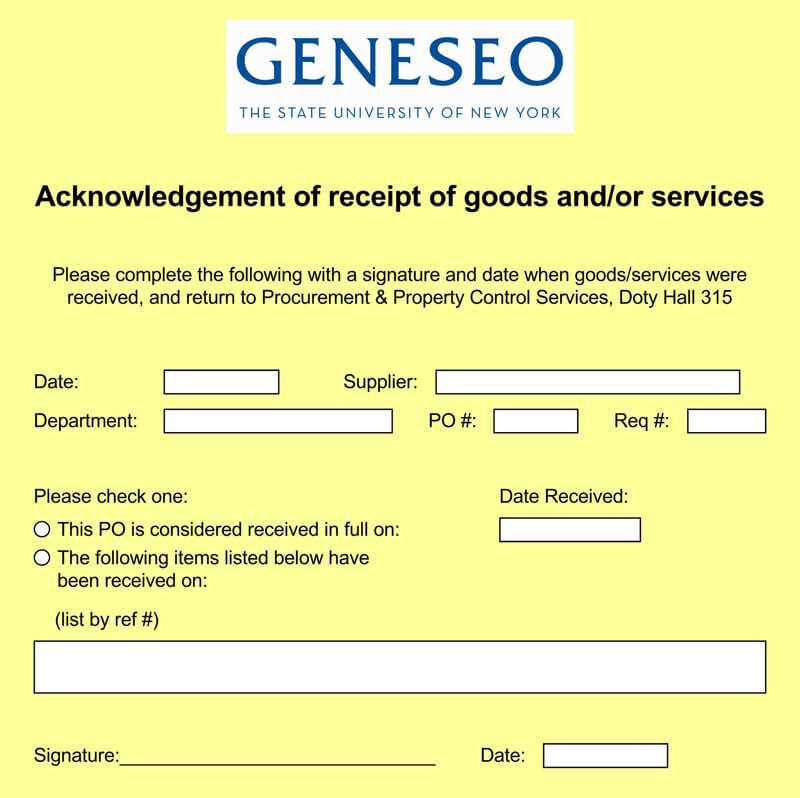
Ensure smooth transactions and clear record-keeping by using a structured acknowledgment of receipt. This document confirms that goods have been received in proper condition and serves as proof for both sender and recipient. A well-prepared template reduces disputes and simplifies inventory tracking.
Include key details such as the date of receipt, a description of the items, quantity, and condition upon arrival. Clearly mention the sender’s and recipient’s names, along with signatures for validation. This prevents miscommunication and helps resolve potential discrepancies.
To improve efficiency, structure the document with clear sections and concise language. A standardized format minimizes errors and speeds up processing. Whether for business transactions or internal logistics, a reliable acknowledgment template enhances accuracy and accountability.
Acknowledgement of Receipt of Goods Template

Confirming the receipt of goods requires clear details to avoid disputes and ensure smooth transactions. A well-structured template should include the recipient’s name, date of delivery, item descriptions, quantities, and any relevant order or invoice numbers.
Specify the condition of the goods upon arrival. If items are damaged or missing, note this immediately and inform the supplier. Clear documentation helps resolve issues quickly.
Include a statement confirming that the recipient has inspected and accepted the goods as listed. A signature line for both parties adds validity, especially for high-value shipments.
Keep a copy of the signed document for records. Digital acknowledgments can also serve as valid proof if properly stored and timestamped.
Key Elements to Include in a Receipt Confirmation

Specify the recipient’s name and contact details to ensure clarity on who acknowledged the goods. Include the sender’s information for reference.
List the items received with precise descriptions, including model numbers, serial codes, or other identifiers. This prevents misunderstandings and disputes.
State the quantity of each item, verifying that the delivered amount matches the expected count. If discrepancies arise, document them immediately.
Note the date and time of receipt. A timestamp serves as a crucial record for tracking deliveries and resolving potential issues.
Confirm the condition of the items upon arrival. If damage is observed, provide specific details and attach supporting evidence if needed.
Include a signature field for the recipient. A signed acknowledgment ensures accountability and finalizes the confirmation process.
Structuring a Clear and Concise Document
Use a logical format with distinct sections to improve readability. Keep sentences short and focused, avoiding unnecessary details. Clearly define each part to prevent misunderstandings.
Key Elements to Include
- Header: Display the document title prominently, including a reference number if applicable.
- Recipient Details: Include the name, company, and contact information of the recipient.
- Shipment Information: List the item names, quantities, and any relevant serial numbers.
- Delivery Date: State the exact date and time of receipt.
- Signatures: Ensure both sender and recipient sign to confirm acknowledgment.
Formatting Tips
- Use tables: Organize item details in a structured grid for clarity.
- Highlight important points: Use bold text for key terms like “Received By” and “Date.”
- Maintain consistency: Keep font sizes and spacing uniform to enhance readability.
Avoid excessive wording and redundant explanations. Keep the content direct and structured to ensure smooth processing.
Legal Considerations and Compliance Requirements
Ensure that the document meets jurisdiction-specific regulations by referencing applicable trade laws, consumer protection statutes, and tax obligations. Identify the governing body overseeing transactions in your region and align the template accordingly to avoid disputes.
Mandatory Information
Include the seller’s and buyer’s legal names, addresses, and tax identification numbers if required. Specify the product description, quantity, price, and any applicable taxes. If electronic signatures are permitted, verify their validity under digital contract laws.
Retention and Auditing
Store signed copies for the legally required duration to comply with record-keeping mandates. Digital records must be secured against unauthorized modifications, ensuring admissibility in case of audits or legal claims.
Digital vs. Paper-Based Acknowledgements: Pros and Cons
Choose digital acknowledgements for speed, accuracy, and automation. Electronic records update instantly, reducing errors and eliminating paperwork. They integrate with inventory systems, ensuring real-time tracking and easy retrieval.
Security and Accessibility

Digital confirmations prevent forgery through encryption and audit trails, while paper receipts can be lost or altered. However, electronic records require backup systems and cybersecurity measures, whereas physical copies remain accessible without technology.
Cost and Sustainability
Paper-based methods incur printing, storage, and disposal costs. Digital alternatives cut expenses and support sustainability by reducing waste. However, initial software investments and maintenance fees may apply.
| Factor | Digital | Paper-Based |
|---|---|---|
| Processing Speed | Instant | Manual handling delays |
| Security | Encrypted, trackable | Prone to loss or tampering |
| Cost | Lower in the long run | Ongoing expenses |
| Environmental Impact | Paperless, eco-friendly | Consumes resources |
Adopt digital acknowledgements for efficiency and security. If legal or operational requirements demand paper copies, use a hybrid approach to balance reliability and convenience.
Common Mistakes to Avoid When Drafting the Template
Use precise language. Vague terms create confusion and may lead to disputes. Specify product details, quantities, and conditions without ambiguity.
Avoid missing key details. Always include the date of receipt, recipient’s name, and a reference number. These elements ensure traceability and accountability.
Ensure clarity in acknowledgment statements. Phrases like “Received in good condition” can be misleading. If applicable, specify any damages or discrepancies.
Do not overlook legal implications. If the document serves as proof of ownership transfer, consult legal guidelines to avoid liability issues.
Keep formatting consistent. Misaligned sections, varying font sizes, or missing fields can cause misinterpretation and make record-keeping difficult.
Prevent signature omissions. A document without an authorized signature lacks validity. Ensure all required parties sign before finalizing.
Check for missing contact details. A recipient’s full name and contact information help in case of follow-ups or disputes.
Avoid redundant wording. Overcomplicated sentences slow down processing. Use direct and concise phrasing to improve readability.
Adapting the Template for Different Business Needs
Customize the template to match the specific processes of your business. A standard acknowledgment of receipt may not reflect the unique elements of your operations, so adapt accordingly to make it functional and relevant.
Adjusting for Industry Requirements
- For retail: Add information about the condition of goods upon receipt. This ensures clarity about product quality and helps handle returns more smoothly.
- For manufacturing: Include fields for product serial numbers and batch numbers to maintain traceability.
- For logistics: Incorporate tracking numbers and delivery methods for transparency in shipments and deliveries.
Incorporating Specific Business Terms
- Use your business’s terminology to simplify communication. Replace generic terms with those familiar to your team, such as “warehouse receipt” instead of “delivery confirmation” for internal use.
- Ensure the template reflects your company’s policy, such as adding a note about any delivery-related fees or specific conditions that may affect how goods are received.


